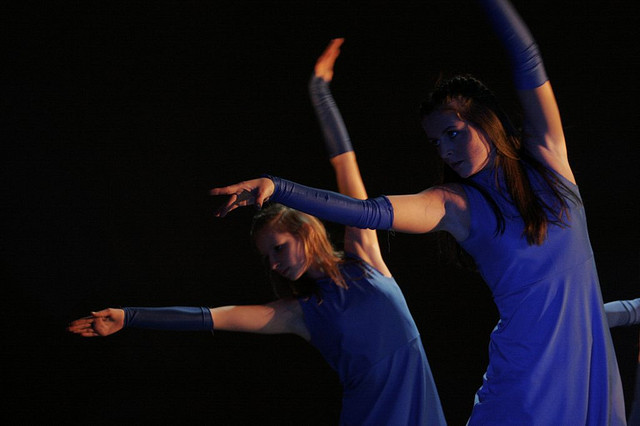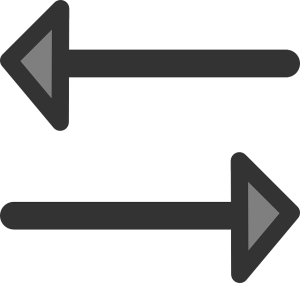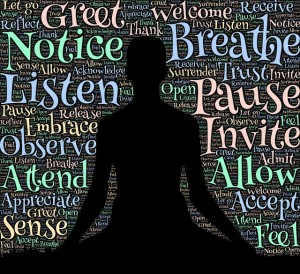
by Karen Musey
Each competition experience brings new highlights and challenges! How time is utilized in-between events is a big factor in determining how each dance studio and dancer excels at each event, and how they grow over the year.
Keeping choreography fresh and spirits high after drilling and performing the same material week after week for months at a time can be a challenge! As dancers find their groove within the choreography, sometimes they start to sit back when they feel that they’ve accomplished the task. Also, often the choreographer is no longer on hand to continue the development of the work. It is important to maintain the structure of the piece, as well as encouraging each dancer to continue to evolve their own interpretation and ideas of it.
The more dancers move out of a neutral approach to performing their piece, the more the piece will evolve and affect the audience. And PS – continually finding ways to improve, define and deepen the work is great preparation for understanding how to develop work as a professional dancer; it is also a great skill to develop for any job…
Deepening The Work
Play! – Once the piece is memorized and the muscle memory has set in, then the artist is free to explore! If you can experience your piece through different kinds of filters (just like Instagram!), you will discover new layers and depth within the choreography. For example – changing up how we work with resistance helps us to discover different kinds of qualities in a movement. Moving through peanut butter vs feeling like you are made of bubbles vs oozing like green slime all change the dancer’s interpretation of the same movement, which opens up new possibilities of expression.
 If a piece has a light, carefree expression to it, try approaching the choreography from an opposite angle – tension, gravity, labored. After experiencing the opposite, turn the filter back in the reverse direction, to extreme lightness and fluidity – more than was experienced originally. You will find that the piece will naturally want to lean in a certain direction. Changing the intention will open up new ideas in how the choreographer was interpreting the music. Maybe adding more lightness creates more freedom. Maybe adding weight and stillness creates a stronger emotional impact in the choreography. Maybe the intention stays the same, but now the original movement has expanded in feeling and has more nuance and variation. Playing with an opposite intention against the original goals of the choreography can open up huge, new emotional spectrums in the piece. Finding unexpected pockets in movement for hope, sadness, sweetness, longing, and connection is wonderful to discover.
If a piece has a light, carefree expression to it, try approaching the choreography from an opposite angle – tension, gravity, labored. After experiencing the opposite, turn the filter back in the reverse direction, to extreme lightness and fluidity – more than was experienced originally. You will find that the piece will naturally want to lean in a certain direction. Changing the intention will open up new ideas in how the choreographer was interpreting the music. Maybe adding more lightness creates more freedom. Maybe adding weight and stillness creates a stronger emotional impact in the choreography. Maybe the intention stays the same, but now the original movement has expanded in feeling and has more nuance and variation. Playing with an opposite intention against the original goals of the choreography can open up huge, new emotional spectrums in the piece. Finding unexpected pockets in movement for hope, sadness, sweetness, longing, and connection is wonderful to discover.
Change Up Phrasing – To create stronger dynamics within phrases, use different imaginative texture ideas like attacking, carving, sticking, melting, tapping. Sometimes adding in abstract concepts like color can help to create new interpretations. What color does your piece feel like? Yellow – happy? Red – anger? Blue – calm? Black – oppression? Green – growth? Could it be a mix of two or three colors? Did it help? Hinder? If it hindered, figure out the opposite word/feeling and play with that idea.
Investigate – As a dancer, it is so important to be curious and ask yourself questions about the choreography you are presenting.
 What is the goal of this piece?
What is the goal of this piece?
How do I want to impact my audience? What kind of emotional experience do I want to my audience to have? Do I want to challenge the belief about a commonly held idea and offer a new one for the audience to wonder about?
How do the words, music, melody and tempo affect me personally? What can I do to increase the stakes for myself, so that I can deepen my personal experience and expression of my piece?
If this piece is about a conflict (for someone or something), do I know the important information – the who, what, where, why and how? By the end of the piece, how do I resolve the conflict? How does knowing the reason change the way I interpret the movement?
Am I stuck in one emotion or approach for the entire piece, or can I change it up? Are there moments that are more interior and hidden, and others that are public and bombastic? How can I increase the feeling of risk and intensity for the audience?
Using action words to create emotional filters – to long for, to wish, to flirt, to protect, to stand your ground, to explode – can help dancers personalize and define their piece further.
Weekly Focus
 Listen – Please listen to the judges’ critiques – it is so important! Judges are hired because of their professional experiences, as these have influenced how they developed as performers and teachers. They are also an outside, unbiased eye and can offer a different perspective. Hopefully you get lots of great feedback to work with in the studio.
Listen – Please listen to the judges’ critiques – it is so important! Judges are hired because of their professional experiences, as these have influenced how they developed as performers and teachers. They are also an outside, unbiased eye and can offer a different perspective. Hopefully you get lots of great feedback to work with in the studio.
If the judges have an opportunity to speak to the dancers and the audience, what are they trying to communicate, and how can you apply it? If you have done a number of solos or small numbers where you are featured and they keep saying the same things, don’t brush it off. Take the time to figure out what the meaning is behind the suggestion.
Outline – To create a focused and proactive practice session, it is helpful for the rehearsal director and dancer(s) to outline goals before and at the end of every meeting. Discuss the previous goals and if they had an impact (positive or negative), talk about positive strides that were made and celebrate them! For the last few minutes of the rehearsal – do a quick review of everything that was focused on. Agree on clear, measurable and attainable goals for the week.
Technique Classes – Don’t forgo them! Many times choreography is very one sided, and it is so important to develop strength and flexibility evenly in the body (right and left sides, upper and lower body) for injury prevention. Competing kids are still growing! Teachers who provide balanced training (strength, flexibility, working with each side of the body evenly) create a solid foundation for young dancers to develop in a healthy way – physically, mentally and emotionally – so that they are set up to lead long, healthy lives and prevent injury from imbalance. Take time to properly warm up and cool down, at the studio and in the competition setting.
Celebrate!
 Circle Up – This was one of my favorite pre-performance rituals when I was a young competing dancer! We would stand in a circle before each piece, and hold hands. Everyone would contribute one aspect or goal of the piece (as well as positive reminders – have fun!). We then squeezed our partner’s hand to send everyone good energy and feel connection. Circling up did amazing things for boosting relationship, connection and trust in our ensemble on and off the stage.
Circle Up – This was one of my favorite pre-performance rituals when I was a young competing dancer! We would stand in a circle before each piece, and hold hands. Everyone would contribute one aspect or goal of the piece (as well as positive reminders – have fun!). We then squeezed our partner’s hand to send everyone good energy and feel connection. Circling up did amazing things for boosting relationship, connection and trust in our ensemble on and off the stage.
Developing your own fun and meaningful studio ritual goes a long way for building team morale, especially during challenging weekends. While competition schedules often require quick changes from one number to the next (often in succession), even taking 20 seconds to circle up and feel the energy in the circle can really change and contribute to the dynamics onstage. Create a habit that before every performance, you agree on a time and place to connect. Regardless of the hubbub backstage and in the changing rooms, finding a time and a space to recenter before each performance really helps dancers focus on the immediate goal.
As a professional performer, I, and many other performers like creating rituals to connect with fellow performers before each performance starts. I personally find it very grounding, as it helps solidify my focus and be fully present for the show. It allows me to be completely available to tackle the amazing and the unexpected moments onstage as they happen.
We often get caught up in the technical executions of dance, and forget the reasons we started in the first place. Dance gave us an incredible opportunity to express ourselves fully in a way that is indescribable! When dancers rediscover the fun and joy in being creative with their movement, they discover the hidden treasures and moments in their choreography. Being fully invested in allowing the choreography to continually unfold creates the electrifying experience of dancing the piece, as if for the first time, every time.

Contributor Karen Musey is a dynamic Canadian born, New York based performer, teacher and dance adjudicator. Her training includes study at Canada’s Royal Winnipeg Ballet Professional Division, The Banff Centre, EDGE PAC (LA), Upright Citizen’s Brigade, The Barrow Group, Kimball Studio, Canada’s National Voice Intensive, Comic Strip Live and more.
Karen Musey judges national and regional dance competitions and festivals across the United States and Canada. She was a Director/Choreographer Observership Candidate during the 2011/12 season with Stage Directors and Choreographers Union and has served as a rehearsal director and dance captain for KOBA Family Entertainment. Karen Musey is an ABT® Certified Teacher, who has successfully completed the ABT® Teacher Training Intensive in Pre-Primary through Level 5 of the ABT® National Training Curriculum. She is a U.S. Member of the International Dance Council CID, recognized by UNESCO.
Performing highlights – PHISH at Madison Square Garden; World Premiere of the Canadian Opera Company’s Das Rheingold (Wagner Ring Cycle); National Artist Program Gala for the 2003 Canada Winter Games; for HRH Queen Elizabeth II during the Golden Jubliee Tour; Chicago (Rainbow Stage); comedy short Foreign Exchange (72 Hour Asian American Film Shootout); music videos for The Guards and Malynda Hale; international tours and performances with The Young Americans, J.A.R. Productions and KOBA Family Entertainment; stand up and sketch comedy around New York; Bravo! documentaries, films and more. She is currently co-writing a play. www.karenmusey.com




